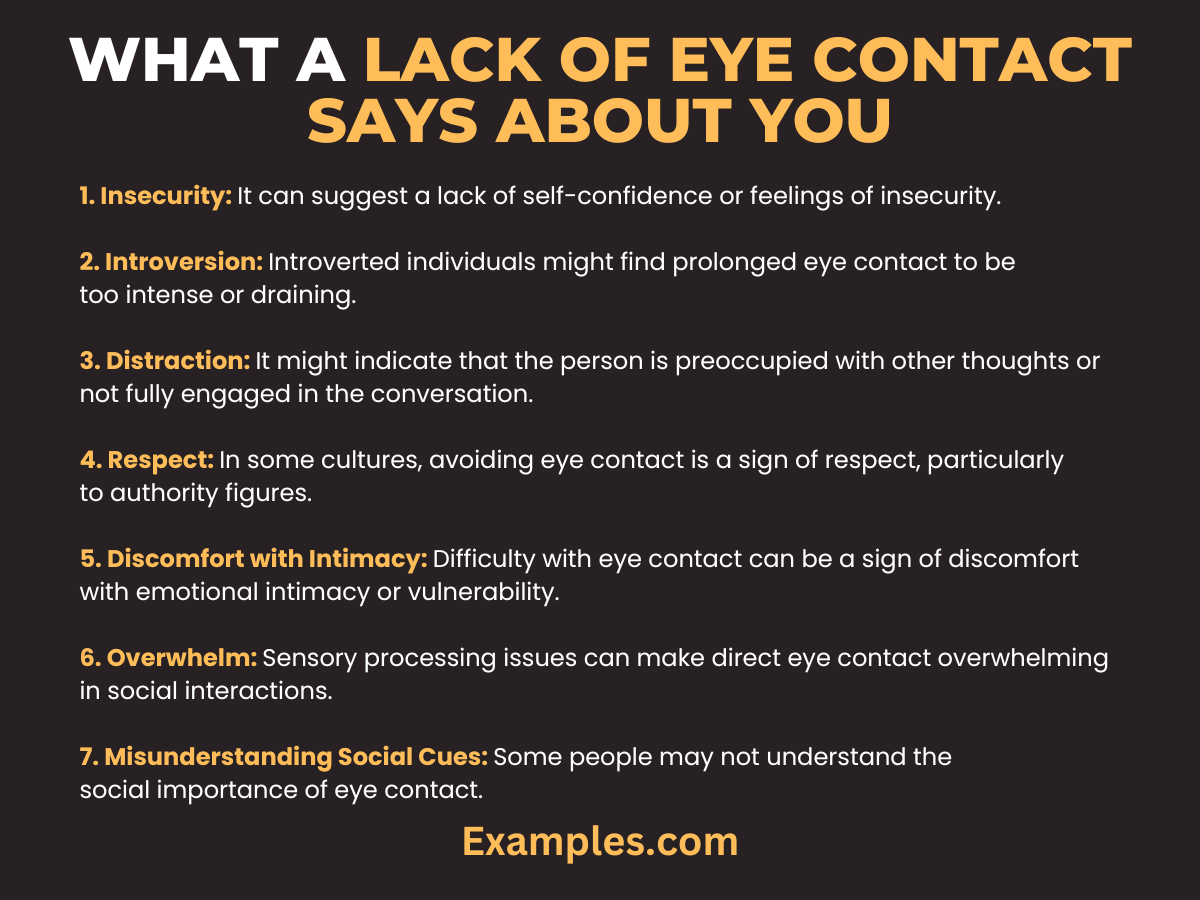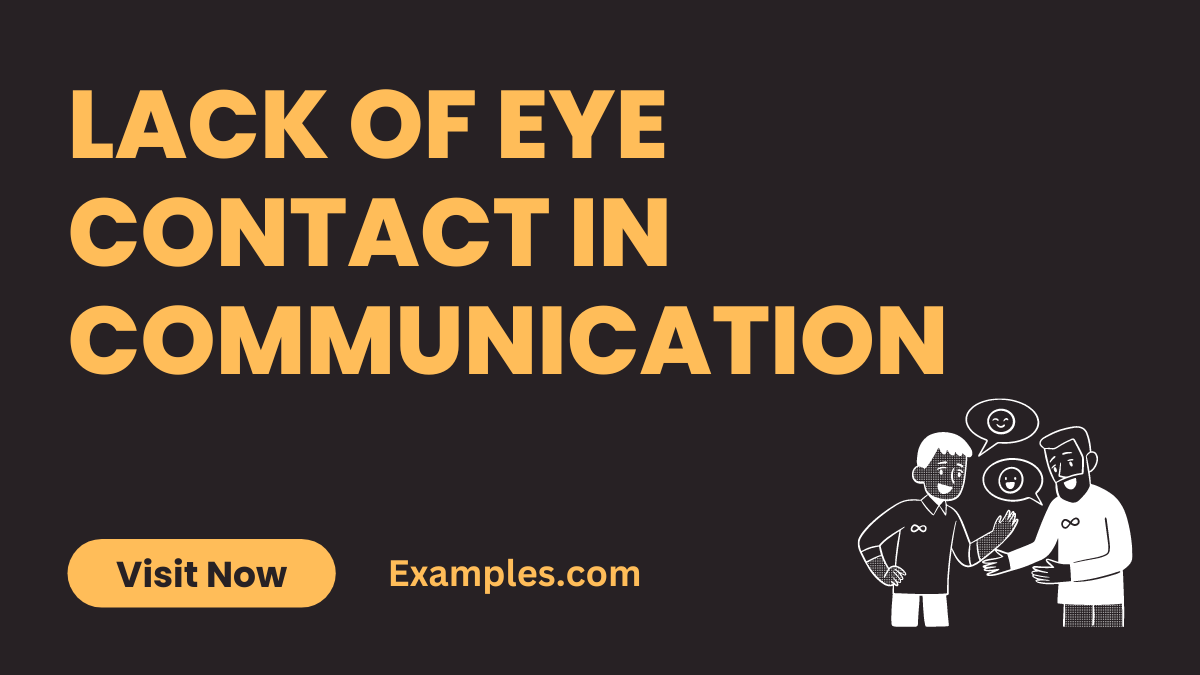20+ Lack of Eye Contact in Communication Examples
The lack of eye contact in communication often signifies more than just a simple habit; it’s a profound aspect of non-verbal communication that can reveal underlying issues or cultural influences. This guide delves into the nuances of eye contact, its meaning, and its role in conveying messages. Understanding this aspect is crucial for improving overall communication skills, especially in professional environments and personal relationships where misinterpretations due to lack of communication can have significant impacts.
What Causes Lack of Eye Contact in Communication?
Eye contact is a crucial aspect of effective communication. However, there are various reasons why individuals might avoid eye contact. Here are eight key causes:
- Social Anxiety: Individuals with social anxiety often struggle with maintaining eye contact, as it can feel overwhelmingly intense and invasive.
- Cultural Differences: In some cultures, direct eye contact is considered disrespectful or confrontational, leading to avoidance in communication.
- Lack of Confidence: A lack of self-esteem can make a person feel unworthy of holding someone’s gaze, resulting in avoided eye contact.
- Neurological Disorders: Conditions like Autism Spectrum Disorder can affect a person’s ability to engage in typical social cues, including eye contact.
- Preoccupation: Being mentally distracted or engrossed in one’s thoughts can lead to lack of eye contact in communication.
- Disinterest: Lack of eye contact can be a non-verbal cue of disinterest or boredom in the conversation or the person speaking.
- Deception: Sometimes, avoiding eye contact is associated with dishonesty or the reluctance to speak the truth.
- Trauma: Past traumatic experiences can make direct eye contact challenging, as it may trigger vulnerability or discomfort.
What does it mean when someone doesn’t make eye contact with you?
When someone avoids making eye contact, it can signal various things. It may indicate discomfort, lack of interest, or social anxiety. It’s important to consider the context and the individual’s usual behavior patterns before jumping to conclusions. Lack of eye contact doesn’t always mean negativity; sometimes, it’s just a personal or cultural trait.
What a Lack of Eye Contact Says About You?

Not maintaining eye contact can convey several messages about a person:
- Insecurity: It can suggest a lack of self-confidence or feelings of insecurity.
- Introversion: Introverted individuals might find prolonged eye contact to be too intense or draining.
- Distraction: It might indicate that the person is preoccupied with other thoughts or not fully engaged in the conversation.
- Respect: In some cultures, avoiding eye contact is a sign of respect, particularly to authority figures.
- Discomfort with Intimacy: Difficulty with eye contact can be a sign of discomfort with emotional intimacy or vulnerability.
- Overwhelm: Sensory processing issues can make direct eye contact overwhelming in social interactions.
- Misunderstanding Social Cues: Some people may not understand the social importance of eye contact.
- Hiding Emotions: Avoiding eye contact can be a way to hide one’s true feelings or reactions.
Importance of Eye Contact in Communication
Eye contact plays a vital role in communication for several reasons:
- Establishing Connection: Eye contact helps in building a connection and conveying interest in the conversation.
- Expressing Honesty: It is often associated with sincerity and honesty in communication.
- Enhancing Understanding: Non-verbal cues through eye contact can greatly enhance the understanding of the message.
- Showing Respect: In many cultures, eye contact is a sign of respect and attentiveness.
- Facilitating Engagement: It keeps both the speaker and the listener engaged in the conversation.
- Conveying Confidence: Maintaining eye contact can exhibit confidence and assertiveness.
- Regulating Conversation: Eye contact helps in regulating the flow of conversation, signaling when to speak or listen.
- Emotional Connection: It can convey empathy, compassion, and understanding in interpersonal interactions.
Tips to Improve Eye Contact in Communication
Improving eye contact can enhance communication skills. Here are eight tips:
- Practice: Start by practicing in less intimidating situations or with friends and gradually increase the challenge.
- Be Mindful: Be conscious of your eye contact habits and actively work to maintain eye contact.
- Use the 50/70 Rule: Maintain eye contact for 50% of the time while speaking and 70% while listening.
- Eye Contact, Not Staring: Ensure your eye contact is gentle and not perceived as staring.
- Balance: Distribute your gaze among a group if you are speaking to multiple people.
- Mirror the Other Person: Try to match the level of eye contact that the other person is comfortable with.
- Focus on One Eye: If direct eye contact is too intense, focus on just one of the person’s eyes.
- Practice with Video Calls: Use video conferencing as a less intimidating way to practice eye contact.
Lack of Eye Contact in Communication is not just a symptom but a barrier in nurturing healthy interactions, be it in personal relationships or professional environments. Understanding and addressing the Causes & Reasons for Lack of Communication paves the way for stronger connections and improved communication skills. Recognizing the significance of eye contact is a crucial step towards fixing communication gaps, fostering trust, and building stronger bonds in all aspects of life.



